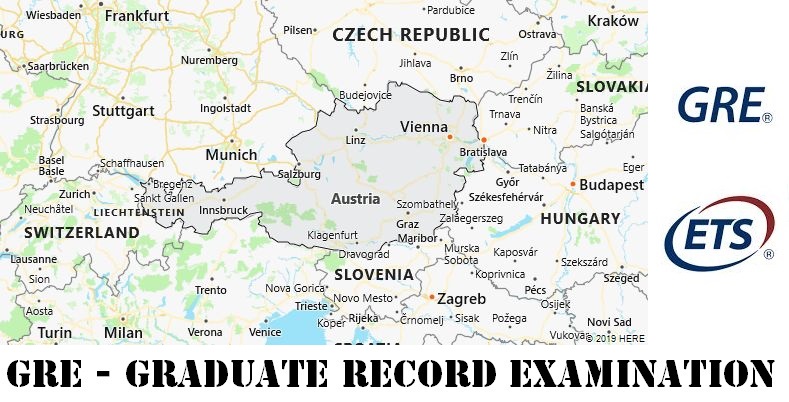GRE Testing Locations
Decided to take GRE exam? Now it is time to determine where to take the test. This site provides a full list of GRE testing centers in Austria, among which, you can choose one that is nearest to you. Good news is that the following GRE test locations in Austria offer both GRE general test and the GRE subject tests.

- VIENNA, AUSTRIA – APCU-8271
WIFI Wien, Waehringer Guertel 97, Wien, Building C – 4th Floor, Room # C422, Vienna
Austria A1180
Computer Based Test
GRE Test Dates
There are two types of test format offered by the test maker – ETS: Computer-delivered and Paper-delivered GRE general tests. For computer based test format, the GRE General Test is offered year-round on a continuous basis, and available for registration on a first-come, first-served basis. For paper based general test, testing is available three times per year. The following test dates apply:
| Test Dates for Paper Based | Deadlines for Registration | Scores Available |
|---|---|---|
| November 09, 2019 | October 4, 2019 | December 20, 2019 |
| February 1, 2020 | December 27, 2019 | March 13, 2020 |
GRE Subject Tests in Austria
The GRE Subject Tests are available on paper based only. In all GRE test centers throughout the world (both inside and outside United States), the exam is available three times a year. The three test dates are:
- April
- September
- October

More about Austria
History
2,000 years ago, Celts and Romans lived in what is now Austria. After the end of Roman times, Slavs, Alemanni, Bavarians (Bavaria) and Hungarians came to the country. In 996 the name “Ostarrichi” (= the empire in the east, Austria) appeared for the first time in a document.
In 1156 the mark was converted into a duchy. From 1273 the Habsburgs ruled Austria for more than 600 years. The Austrian state was founded in 1804 with the “Austrian Empire”. From 1867 to 1918 the state was called »Austria-Hungary«. A dual monarchy with two parts of the country replaced the empire. The head of state was the emperor from the Habsburg dynasty. Since he was king of Hungary at the same time, the state was called “imperial and royal” monarchy, or in short: k. u. k. Monarchy. In 1914, the assassination attempt on the Austrian heir apparent in Sarajevo triggered the First World War.
After the First World War, the multi-ethnic state was dissolved and the dual monarchy was split up in the Peace of Saint-Germain (1919): the remaining territories of the former Danube monarchy became the independent federal state of Austria. Bohemia and Moravia, South Tyrol and South Styria had to be ceded, among other things. Hungary and Czechoslovakia emerged as successor states. In 1938 German troops marched into Austria and the “Anschluss” to the German Reich until 1945 followed.
After the end of the Second World War, Austria’s independence was restored, but the country was divided into four zones of occupation. The Allied occupation ended with the conclusion of the Austrian State Treaty on May 15, 1955. Austria committed itself to permanent neutrality on October 26, 1955. The country is one of the founding members of the European Free Trade Association in 1960 and has been a member of the European Union since 1995.
Culture
The Habsburgs had a decisive influence on Austria’s culture. They brought important composers such as Joseph Haydn , Wolfgang Amadeus Mozart and Ludwig Beethoven to Vienna and made the city the center of European musical life in the 18th century. The era is called the Viennese Classic. The Viennese waltz emerged from Austrian folk dances in the 19th century. Thanks to the Danube waltz by Johann Strauss (son) the whole world knows that Vienna lies on the »beautiful blue Danube«. “Silent Night, Holy Night” is one of the most famous Christmas carols. It was created over 200 years ago in the Austrian state of Salzburg.
Arnold Schönberg , Anton von Webern and Alban Berg are considered composers of Viennese Modernism. This is how cultural life in the Austrian capital around the turn of the century (from around 1890 to 1910) is described. Writers like Arthur Schnitzler (* 1862, † 1931) and Hugo von Hofmannsthal also shaped this trend. You were among the most important critics of the Austro-Hungarian monarchy. Viennese Modernism is often called »coffee house literature« because the artists regularly met in cafés to discuss things with one another. Well-known contemporary writers are, for example, the Nobel Prize winner for literature Elfriede Jelinek , Marlene Streeruwitz (* 1950) and Peter Handke , who received the Nobel Prize for Literature in 2019. The author Christine Nöstlinger has written many books for children and young people. One of her most famous characters is little Franz.
The painters Egon Schiele (* 1890, † 1918) and Oskar Kokoschka (* 1886, † 1980) are among the most important representatives of Austrian Expressionism. The artist Friedensreich Hundertwasser (* 1928, † 2000) is known for his colorful works of art. In addition to graphics and images, he designed numerous buildings, such as the Hundertwasserhaus in Vienna. No two windows are the same.
Austrians are known for their very idiosyncratic black humor. There is a lively cabaret and cabaret scene in the country. Winter sports in Austria means, for example, skiing, snowboarding, biathlon and cross-country skiing. The Four Hills Tournament is the most important championship in ski jumping. Two of the four competitions will take place in Austria, in Innsbruck and in Bischofshofen. But football is also very popular in the Alpine country.
